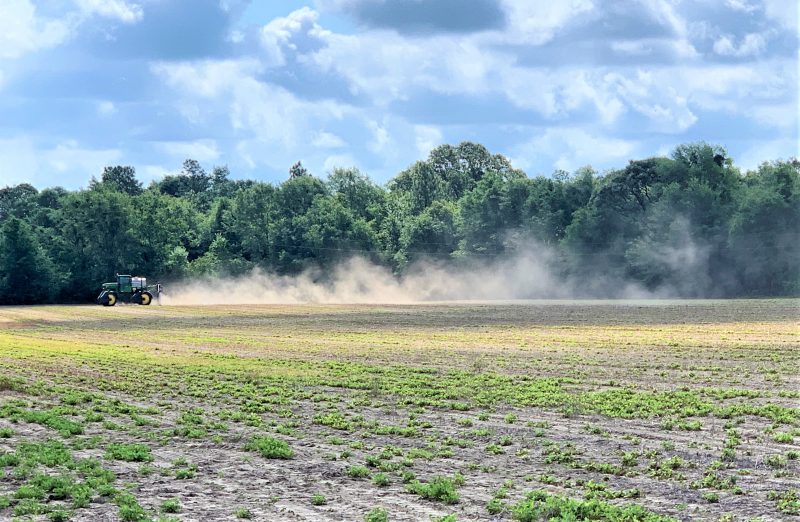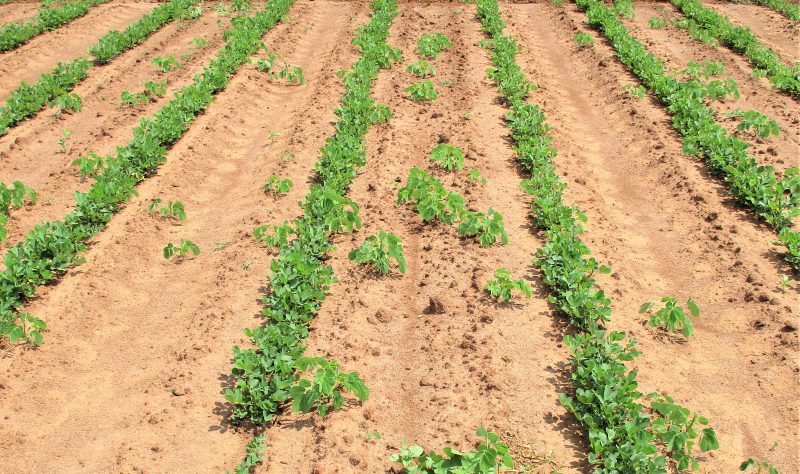
A sprayer applying herbicide on a hot, dry day in the Florida Panhandle. Credit: Pratap Devkota, UF/IFAS
For the past several weeks, the Florida Panhandle has experienced hot and dry weather conditions. Unfortunately, these environmental conditions coincided with most of the pre-emergence (PRE) and early post-emergence (EPOST) herbicide applications. So, what could happen to your herbicide activity during these situations? The general understanding is that herbicides do not perform at their best if the environment is not favorable for plant growth. Considering this, due to the hot and dry conditions, you may not get optimal weed control from the PRE and POST applications you made this season.
For PRE herbicides to work well they need to be incorporated or activated by rainfall or irrigation into the effective soil zone, so that emerging weed seedlings can absorb the herbicide. Without timely rainfall it is likely that PRE herbicides will remain on the soil surface and have limited activity on emerging weeds. Another issue during dry and hot conditions, PRE herbicides remain on the soil surface and are likely to get degraded by sunlight. Some PRE herbicide products are more photo degradable and prone to volatility loss (Prowl, Sonalan, Treflan etc.) than others (Valor, Strongarm, Staple, Reflex, Sencor, Aatrex, Direx etc.). However, when properly incorporated into the soil volatile herbicides (Prowl, Sonalan, Treflan etc.) are actually better off during drought conditions, because they do not vaporize as much in dry soil as in wet soil. The amount of time from when PRE herbicides are applied to when they start to break down on the soil surface varies by herbicide chemistry. In general, proper incorporation or activation is needed within few days after volatile herbicide application, and within 1 to 2 weeks after non-volatile PRE herbicide application.
Hot and dry weather conditions can critically influence activity of POST herbicides as well. Weeds which have emerged early in the season, or species that are more drought tolerant will show reduced response to POST applications. Weeds growing in the hot and dry conditions are stressed (like crops), produce more wax in the cuticle, slow down the rate of biosynthetic processes (fatty acid, amino acid, protein, photosynthesis, cell division, and meristematic tissue growth) required for herbicide activity, and become tougher than weeds growing in favorable temperature with good soil moisture. The weeds with increased waxy cuticles on the leaf absorb less of the applied herbicides. Likewise, reduced transpiration rate and biochemical processes in the weeds slowdown herbicide translocation and action into the target-site.

Sicklepod in a peanut field. Sicklepod has more perpendicular leaf droop in the afternoon than in the morning. Credit: Pratap Devkota, UF/IFAS
POST herbicide activity could be influenced by the alteration in leaf architecture exhibited by plants during hot and dry conditions. Leaves fold and droop perpendicular to ground during hot and dry conditions, which compromises herbicide coverage. Likewise, the evaporation rate for spray droplets are higher during hot and dry conditions. This leads to faster drying of spray droplets resulting into reduced herbicide absorption. The herbicide products with systemic activity are more prone to compromise weed control efficacy during hot and dry conditions than contact type products. The products containing glyphosate (Roundup etc.); dicamba (Clarity, Banvel, Xtendimax, Engenia, Fexapan etc.); 2,4-D (2,4-D Amine, 2,4-D LV4, Enlist Duo etc.); 2,4-DB (Butyrac, 2,4-DB etc.); ALS herbicides: imazapic (Cadre), imazethapyr (Pursuit); and grass herbicides: Clethodim, SelectMax, Poast, Fusilade, Assure etc. are some examples of systemic herbicides. For most POST herbicides, the optimal performance is achieved while weeds are growing at air temperature range from 70° to 85°F with ample soil moisture.
Considerations to help mitigate drought effects on herbicide performance:
-
Applying appropriate adjuvants and surfactants is even more critical during hot and dry conditions. Adjuvants and surfactants facilitate herbicide absorption by enhancing spray droplet retention on the leaf surface, dissolving wax cuticles, and holding spray droplets on the leaf for longer duration by lowering evaporation rate. It is essential to follow the herbicide product label and select the proper adjuvants and surfactants.
-
Increasing the herbicide product application rate. It is worthwhile to apply herbicide at the higher end of the product labeled range, than applying at the lower end. This increases the opportunity to get the adequate amount of herbicide absorbed through the leaves of the weeds.
-
Increasing spray volume (GPA) to ensure optimal leaf coverage is also important consideration during hot and dry conditions.
-
Depending upon the product, spraying herbicide with nozzles which produces coarse or extra coarse droplets. Fine or medium droplet dry faster than the coarse or extra coarse droplets.
-
Spraying herbicide earlier in the day when there is more humidity. Higher humidity reduces the spray droplet drying rate as compared to hottest time of the afternoon with the lowest humidity.
-
Spray application during morning hours is also better than in the afternoon, because plants are more hydrated and leaf blades are more open and erect in the morning hours than in the mid-day or later afternoon.
-
As much possible, wait to apply POST herbicide applications until after rainfall following extended drought conditions. This allows weeds to maintain their regular physiological processes which will enhance herbicide activity.
